For about 15 years from the mid-1980s, models such as the 205, 306, 405 and 406 rose above the pack thanks to exciting dynamics married to exquisite design. Of course, greedy pricing and patchy tech – French automatics were always rubbish, for example – meant that their full impact in Australia was somewhat watered down.

In the 2000s, Peugeots degenerated into dreary and at times ugly and unreliable dross, to the point of near bankruptcy a couple of years ago. Today’s billion-euro T9-series Peugeot 308 is Peugeot’s last chance, and its greatest hope.
We’re already fans. In base 96kW e-THP guise, the second-gen 308 has beguiled on several occasions: first on an international drive last September, then at COTY 2014 (where it very nearly beat the winning BMW i3), and most recently in a comparo against the Volkswagen Golf and Renault Megane, though the German pipped the base Access on price, space and equipment.

And now it joins Our Garage for the next six months. Well, seven months as it turns out, because miscommunication on both sides saw a well and truly used 5000km press car from WA arrive on our Melbourne doorstep. This was a golden opportunity because in the weeks before our correct Active 96kW e-THP auto arrived, we experienced first-hand how it stacked up in light of Peugeot’s repeated promise that quality and durability have improved under an obsessive new regime that included 120 percent more testing cycles and more than four million kilometres of research and development.
We added another 5000km in six weeks, criss-crossing Victoria and New South Wales, and not a single squeak, rattle or breakage blotted the Peugeot’s performance. The hard-worked 308 averaged 6.5L/100km while impressing with its spirited acceleration, light-footed handling agility, cosseting ride and brilliant refinement.
A Melbourne-Albury round trip in biblically torrential rain and almost cyclonic winds did not phase the gutsy Peugeot, parting the temporary Hume Highway River like Moses. And we preferred ours to the less supple Allure 1.6 and GT versions we were driving up there to assess. The 1.2 turbo-triple Active is definitely the range’s sweet-spot.
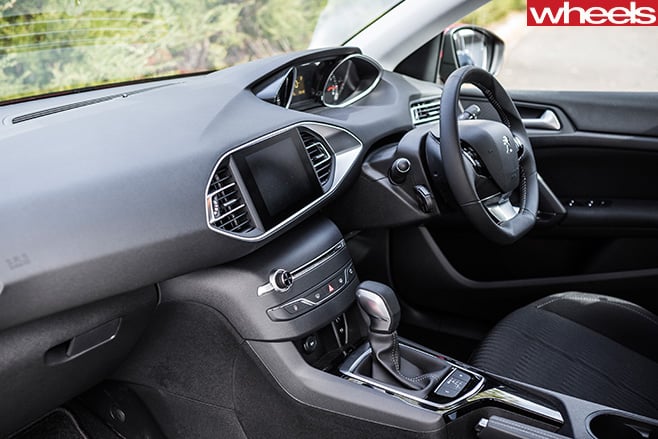
Anyway, in the end we didn’t want to give ‘Bluey’ back, until our lustrously red replacement landed with just 10km on the odometer. What a contrast.
No reversing camera is a massive oversight (though the rear sensors do include a handy ‘pictogram’), but otherwise CWY-07A is well equipped, bringing useful goodies such as Bluetooth phone and audio streaming, lumbar and height adjustment for both front seats, a rear backrest ski-port, multi-function central touchscreen and 16-inch alloys (wearing Goodyear Efficient Grip 205/55R16 tyres that are outstandingly supple).
In 1300km of running-in mileage, the 96kW/230Nm 1.2 three-pot turbo feels almost as peachy as old Bluey’s did at 10,000km.
It’s so encouraging to see that the Peugeot of old is back.
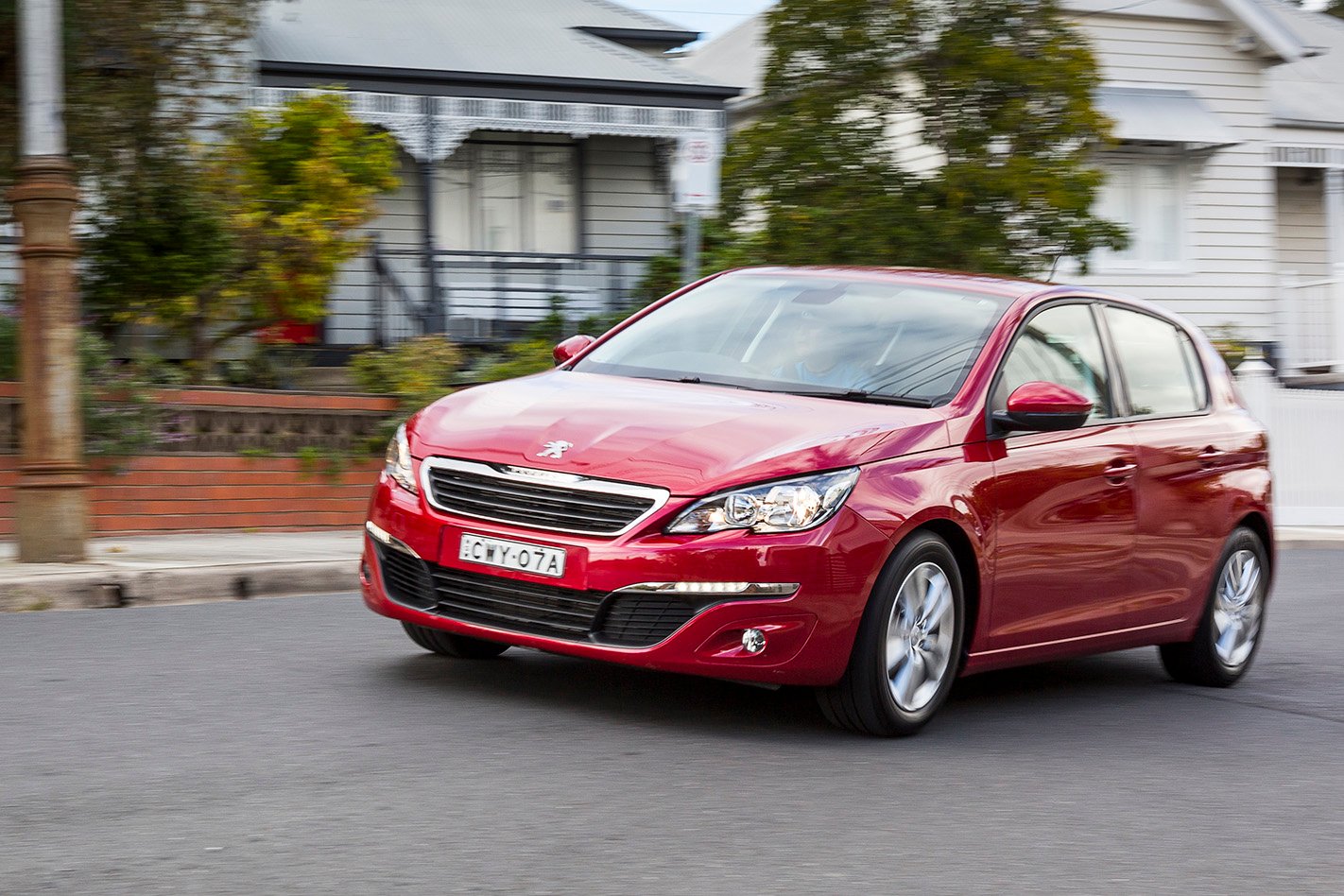
Update 1
Peugeot’s decision to contain the latest 308 within traditional C-segment hatchback dimensions – in other words, small – can work both for and against it.
Two close friends each drive current Volkswagen Golfs, and rarely transport anybody in the back. While the German car’s generous rear-seat space was appreciated the few times it was required, both admit they would probably trade a bit of that extraneous size for more of the parking-friendly compactness and manoeuvrability of the Peugeot.
The 308 is 96mm shorter and 34mm lower than the Golf, though it is 5mm wider, and its 435-litre boot capacity is 55 litres larger. Both sit on a 2620mm wheelbase. Surely the VW offers the better experience for passengers?
You’d think so, but two four-up journeys in the Pug totalling 700km challenged that impression. It was a surprise just how accommodating that French back seat was when carrying two adults of 180 and 165cm.
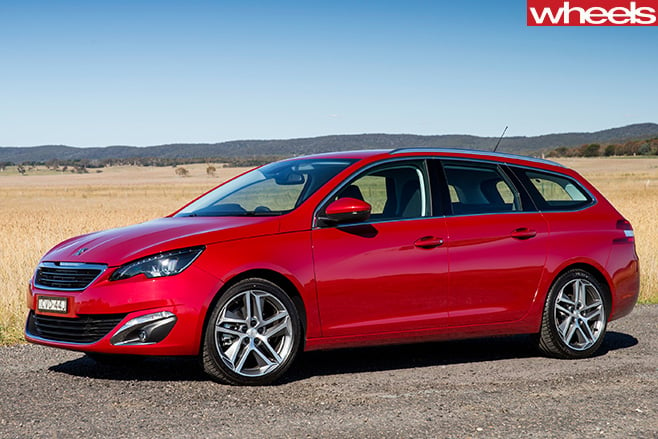
The lack of rear vent outlets – one of our earliest criticisms – wasn’t missed, either, due to the massive centre-dash vents that can supply areas of the cabin some rival cars cannot.
Later it occurred to me that the low seating, narrow rear glass, high parcel shelf and relatively shallow side windows probably make the Peugeot feel more petite inside than it really is.
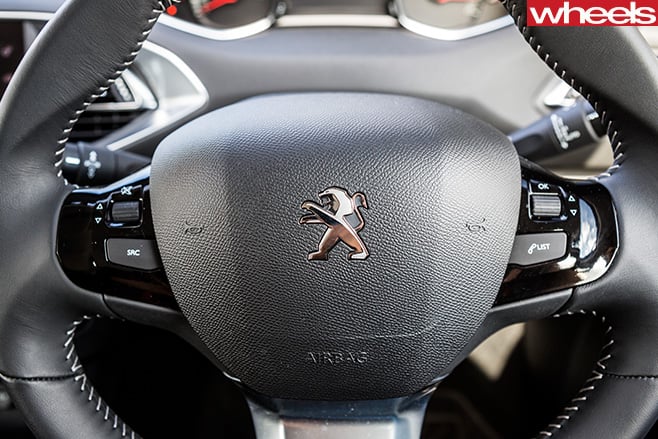
So our Gallic hatchback’s packaging and comfort are not at all hampered by its compactness, and it still feels very grown up in the rough and tumble of city driving.
Even from the back seat, Peugeot’s renaissance continues.
Update 2
Supple ride smooths Byron’s path to true love.
The Peugeot is ruining other cars for me. It has nothing to do with the steering’s unfettered connection with my palms, and everything to do with what I feel from the seat of my pants.
Three months in and the mid-range five-door hatch from France continues to surprise and delight with an incredibly silken ride quality. It’s as if a fresh hot coat of bitumen precedes my every move because the supple and silent suspension absorption has bettered every other 2015 model I’ve driven this year, with the exception of the Ford Mondeo.

We’re talking here about patchy inner-urban streets with pimply surfaces, potholes, crumbling edges, pyramid speed bumps and tyre-shredding tram tracks. And the 308 glides over them, in most cases with utter insouciance. The same applies out on the open road.
Owners of post-war/pre-millennium Pugs may ponder what all the fuss is about, since classics like the 504 (which I own), 306 and 406 were renowned for their lush ride. From about 2001 the French tried (but failed) to emulate BMW dynamics with sub-standard suspension set-ups that traded Teflon smoothness for tetchiness, as many 407 drivers learned the hard way.
Wheels veteran John Carey once said that, while even keen drivers might only demand Lotus-style dynamics 10 percent of the time, everybody can delight in a comfortable ride 100 percent of the time.
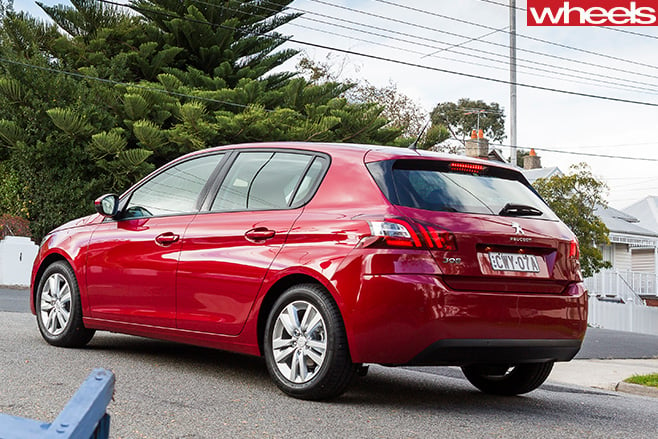
Yet here’s the crux of the Pug’s brilliance, because CWY-07A continues to deliver beautifully fluent steering, wonderfully playful handling and superb body control as well. These, along with a terrific turbo triple that continues to loosen up with mounting mileage, completes this T9-generation 308’s holy-cow dynamic trinity. Peugeot’s engineering magic is back.
You can even argue that it’s never been better, because the (Japanese-sourced) Aisin six-speed self-shifter works so well with the engine’s torque characteristics. It’s the first truly great ‘French’ auto.
Furthermore, fuel consumption (on premium unleaded only) is still in the mid-6s, there’s been not a single rattle or broken piece of trim, the low-wheel/high-instrumentation driving position feels intuitive, and the front seats remain supportive over long distances (and we’ve been on a couple of extensive but completely non-eventful rural jaunts this month).
Rear seat access isn’t up to Golf let alone Skoda Octavia standards, and the roof gutters actually slosh water onto the 308’s alighting occupants in heavy rain, but otherwise my French honeymoon continues.
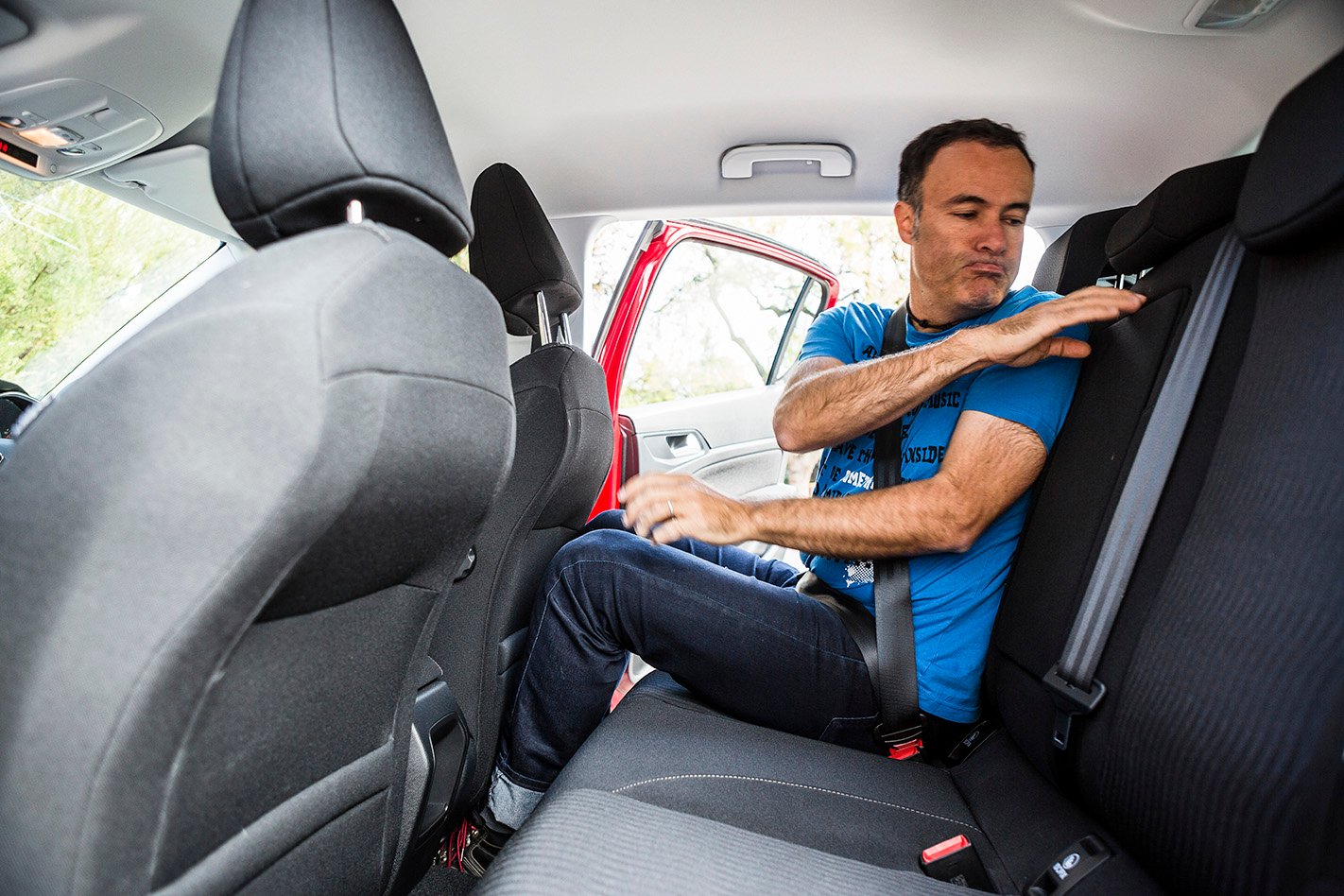
All quiet on the western front
At the 308’s international launch in France last year, Peugeot told Wheels that the 308’s all-new EMP2 platform was engineered to be significantly stiffer and more rigid than the previous one in order to absorb 80 percent of crash forces compared to 50 percent.
This, along with the torsion-beam rear axle’s mounting dampers, unique triangular ‘spacer’ brackets and specific sound-isolating rubber bushes, helps eliminate NVH pathways into the cabin, for a far quieter ride. Additionally, the sound-deadening material was designed-in from the start, rather than added later.
Update 3
308 might be stellar, but some black holes do exist.
IN THE 18 years I’ve been writing about cars professionally, not many have impressed as consistently as the 308 1.2-litre three-pot turbo auto. Four months and 5000km in, the Peugeot’s punchy yet supple driveability, fluid dynamics, restrained class and unbelievably excellent build quality continue to shine brightly.
That makes the faults in this small-car superstar all the more glaring.
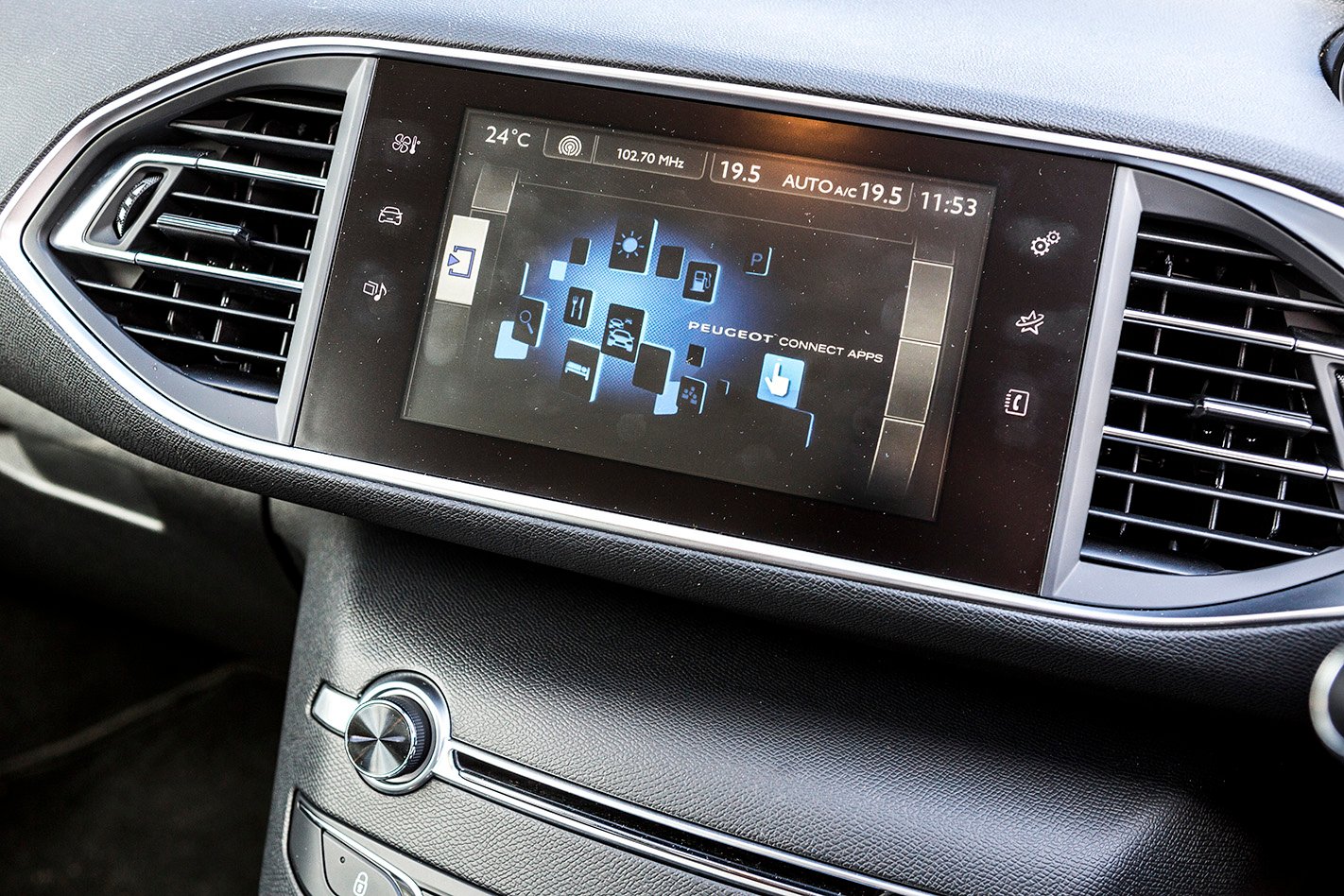
Probably top of the list is the touchscreen’s overloaded functionality. Like an old Merc’s indicator/wiper stalk, it has too many jobs to do, and scrolling between each can be tiresome. For instance, changing the temperature requires a different display ‘window’ followed by hit-and-miss prods of the display. A simple thermostat dial – or even a big old knob just like the one for altering the fine audio system’s volume – would suffice.
That leads to whinge number two, the lack of night-time steering wheel illumination for the remote audio controls, requiring the sort of fumbling in the dark that would bring back embarrassing teenage-years memories for many frustrated drivers.
Once you’ve arrived at your destination, be prepared for an unintended shower if it’s been raining, thanks to the most ineffective roof gutters we’ve experienced in a long time. Thankfully the door pockets are large enough to take an umbrella for just such occasions – unlike the latest Mazda 3’s…
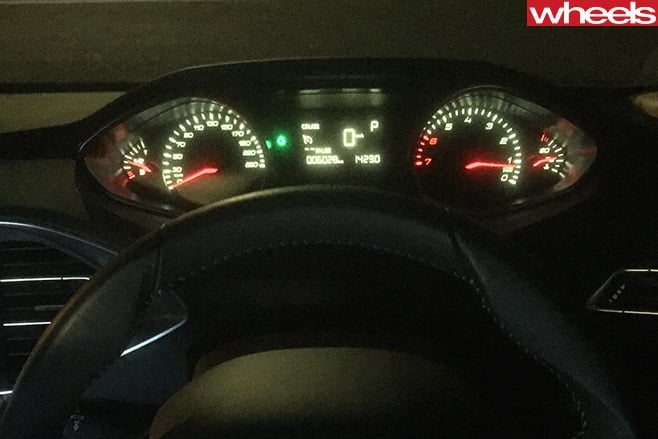
Speaking of dampness, the Active’s Goodyear Efficiency Grip tyres might help damp out road irregularities while eking out maximum fuel economy, but their wet-surface grip can be tenuous. In willing hands, the sliding rubber can be fun, and the chassis’ innate control and adjustability means even novice drivers stand a very strong chance of regaining their intended trajectory, but we’d prefer stickier items. Efficiency Grip? More like ‘Efficiency Slip’.
And finally there is the infernal back-to-front tachometer needle action. This is a bit of a love/hate thing, actually, because it’s obviously done for symmetry’s sake, or just to be different and French, and that ought to be celebrated in this age of uniformity. But, really, how can anybody get used to a reverse-swinging rev counter?
Still, as I approach the end-game in the Pug, I also know that once CWY-07A goes, I’ll miss the bad along with the good because the T9-series 308 is that rarest of beasts – a car with character. It’s what’s been missing in most rivals.
As for the faults, all are minor. What a major achievement.
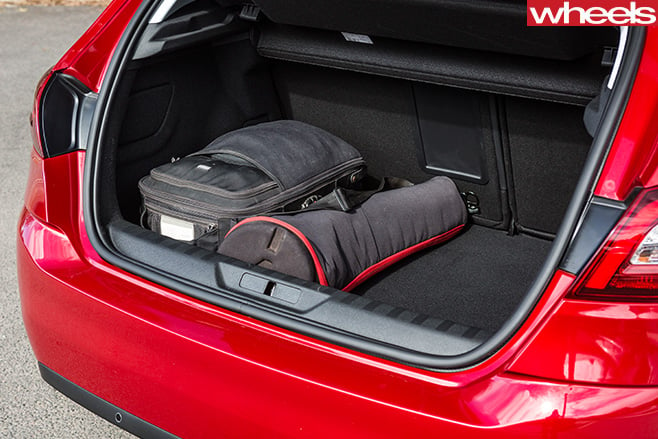
Boot on quality
Peugeot is understandably forever banging on about this 308’s huge quality strides. But rather than take it at face value, punters ought to explore the car’s posterior instead. Or, more accurately, the generous luggage compartment. Right there is evidence of thorough craftsmanship, from the solid operation of the tailgate (which opens up high to clear taller scalps) to excellent fit and finish. There’s nothing shoddy there at all. You might even call it Teutonic in its presentation.
Update 4
What’s thriftier; a 308 running on 95 or 98 RON?
The reason so many manufacturers are moving to smaller-capacity turbo engines is economic rather than for economy. A lower emissions rating means higher sales in many countries due to tax breaks.
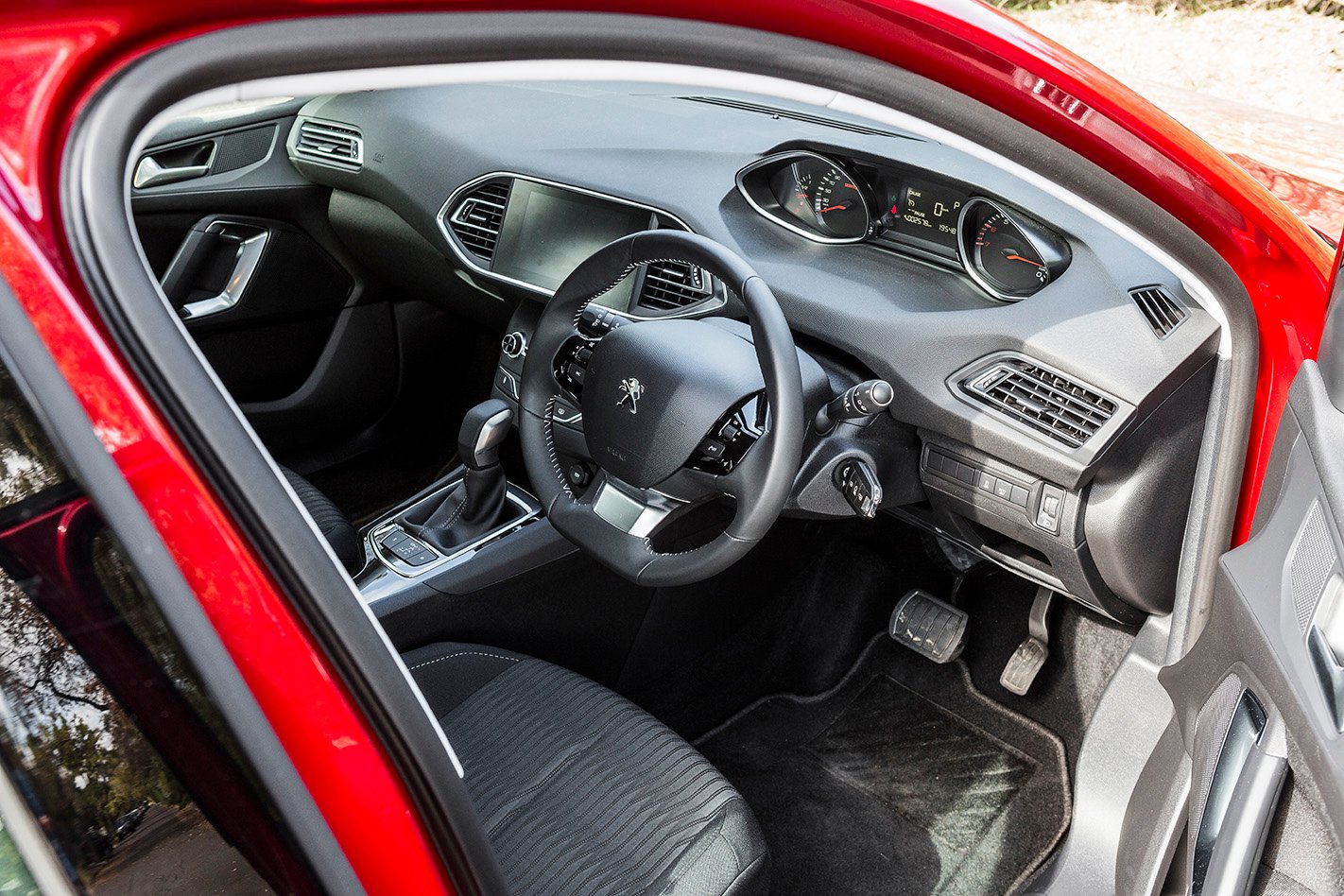
Starting with a clean slate as Peugeot did with the T9 308 means the engineers were able to create a lighter and more aerodynamic car around the terrific 1.2-litre three-pot turbo, maximising the downsizing potential. And, as regular readers know, we’ve revelled in the performance, agility, control and ride comfort of the 96kW e-THP 1.2-litre turbo-equipped Active.
However, for some people, one downside of downsizing is the need to fill them with premium unleaded petrol, due to their higher octane diet demands. While our 308’s triple can run on the standard 91 RON brew, it isn’t recommended.
But what about at the other end of the petrol price scale? Which of the two premium unleaded fuels is better – 95 RON or 98 RON? We normally fill the Pug with the more expensive stuff because that’s what we’ve long believed to be the best for efficiency. To find out for sure, though, we switched to the lower-octane premium bowser for three fills, before returning back to the top-shelf stuff for three more.
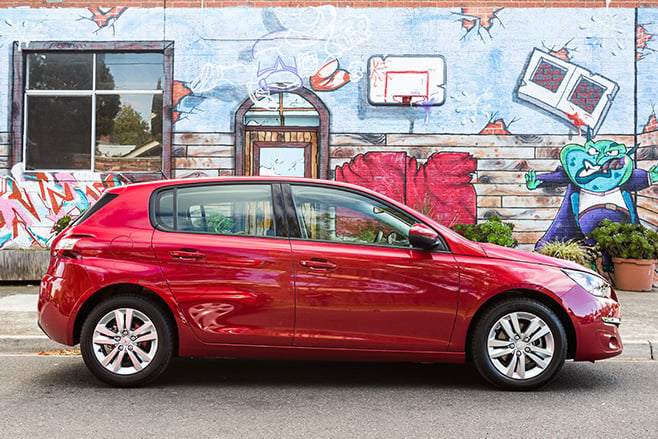
The trio of runs on 95 RON saw CWY-07A average 7.4L/100km, with 7.0 achieved on a country cruise and 7.8 during regular inner-urban schlepping. Back on 98 RON, the average was 6.6L/km, the best was 6.3 and the worst was 6.9. That’s 0.8L/100km better on the richer brew. So, even at 147.9 cents versus 155.9 cents per litre, spending more for 98 RON literally makes cents, because the five percent premium is covered twice-over by an 11 percent consumption decrease. All up, for every 500km driven, we saved $3.25 using the more expensive stuff. Over 20,000km, that’d be about $130.
Obviously prices and gaps fluctuate almost daily, but in our experiment the outcome is a victory for 98 RON – at least as far as our 308 is concerned, and a win-win when you factor in the slightly stronger performance that the premium promises. Yet even on 95 RON, it’s an outstanding result for the tiny turbo triple, as well as a big thumbs up for downsizing.
Help me, RON-da
Educating readers is always a noble endeavour, but the true instigator for our premium fuel fight-out came about when I recently queried CWY-07A’s unusually listless performance. My partner replied: “Oh yes, I filled it up with 95 RON for a change” — the first time he’d done so — thus prompting the experiment. As a scientist, Jim needed convincing about the merit of the full brew, which the result duly delivered. Now he’s a 98 RON convert. And now the 308’s vigour is back.
Update 5
Godzilla storms in, but the Peugeot 308 bravely stands its ground.
In most minds, the definition of a Grand Tourer is a car that reels in the miles with effortless ease.
With me abroad on assignment for much of the month, it was a relentless roster of country runs in the hands of my partner for the hard-working 308 Active, sometimes with three others on board, and always carrying geological paraphernalia. And, just like a Japanese car, the lack of shake, rattle or roll continued to surprise and delight.
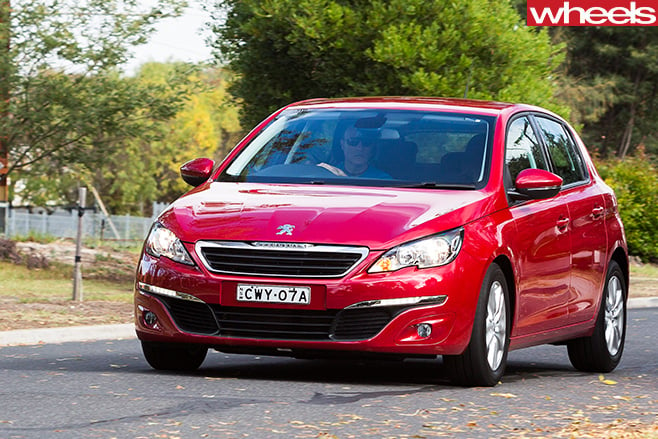
Initially, CWY-07A remained in stasis beneath our borrowed Apollo Bay getaway’s carport, after ably schlepping over a week’s worth of gear and Romy the Lady Labrador Retriever as our holiday workhorse. But after a frenetic few days of roaring along the many glorious little B and C roads of western Victoria, which the GT-R conquered with amazing insouciance, I actually longed for the 308’s light and breezy touch.
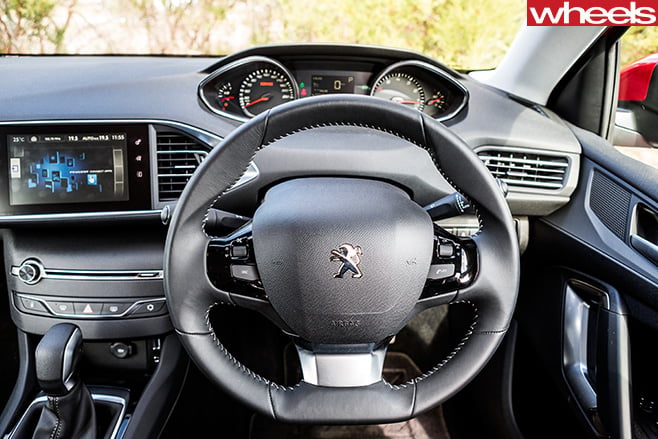
Later on, a wrong turn and my desire to keep on driving led me through some deserted gravel roads, and here the Pug displayed yet another talent. Aided by that superb low-wheel driving position and reactive chassis, the 308 revels in the dirt, the front wheels digging in as the rear slides out gently for some fab rally-style fun. Unperturbed by the many and varied rutted surfaces, the suspension’s ability to soak up all and sundry was just icing on the cliche.
I spent the final couple of days hopping between the two, certain that I was definitely in the company of two great modern yet disparate grand tourers.
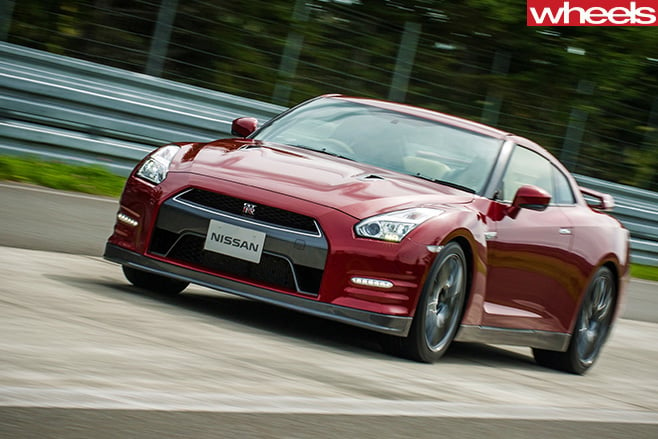
Cruise missile
Like most non-premium vehicles, the 308’s cruise control works fine on a flat road surface, but struggles to keep the vehicle travelling at the set speed when a downhill gradient comes into play, with the pace picking up dramatically as the slope’s angle intensifies. In speed-camera infested Australia, you can’t always rely on the cruise control to save your licence, so beware. Why can’t more manufacturers follow BMW’s example of engineering braked cruise control systems?
Update 6
Much satisfaction, and few blemishes, after 10,000km.
Seven months and 10,737km in, it’s au revoir Melbourne and bonjour Sydney for our French friend, summoned northwards for road-test editor Ponchard to see out its final few weeks with us in the Emerald City.
Actually, make that 16,000km and nine months later because Peugeot Australia delivered the wrong car initially, meaning we’ve in fact run two 308s consecutively.
Such extended exposure has naturally revealed blemishes: The touchscreen layout with separate menus for the audio and climate systems isn’t as intuitive as having actual switches; the cruise control struggles to maintain the set speed on inclines; not every button on the steering wheel is illuminated; the finish in the driver’s footwell area isn’t ship-shape; and are the so-called rain gutters porous?
Speeding fines and wet hair aside, these are minor foibles. Even the lack of a reversing camera – instead there are effective rear sensors with an object proximity pictogram display – didn’t dampen our enthusiasm.
But what about reliability? It’s an issue that has plagued previous Peugeots for years, but incredibly, considering this is a clean-sheet redesign on an all-new platform, nothing has failed, rattled, broken off or busted. With more than four million kilometres of development over 4.5 years, Peugeot reckons it has redoubled quality efforts to ensure that the 308 “looks new after three years/60,000km”. Our experience suggests this might be more than fanciful PR fluff.
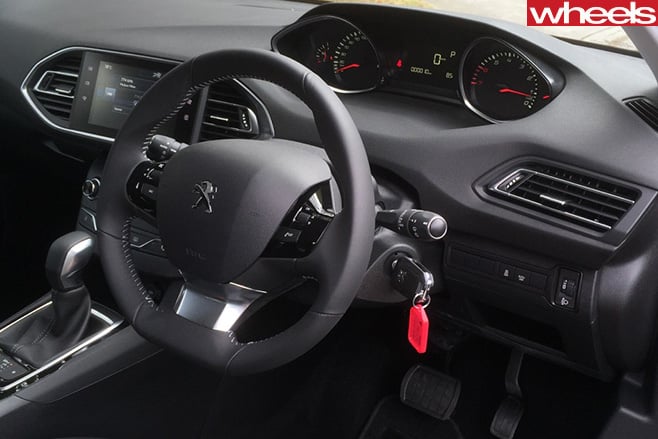
More ownership-enriching engineering is evident in the 140kg-lighter (yet significantly stronger) 308’s fluent dynamics, serving up sweet steering and engaging handling as well as a quiet and soothing ride.
Finally, the Pug scores for packaging – plenty of comfort for two up front, fine for four adults overall (though rear legroom isn’t up to Golf standards) and a sizeable cargo area beneath that world-first composite tailgate.
So CWY-07A has nailed it (so far), cementing what we suspected back when the 308 almost stole last year’s COTY crown – that Peugeot is back at last. What an enjoyable 16,000km. Please try before buying a Golf, Mazda 3 or Focus.
Ponch is in for a treat.
There’s flair in there
Along with the fluid handling and punchy turbo triple, the distinctive dash design is probably the 308’s strongest draw for us after living with it for 11,000km, fusing non-homogenous design, eye-catching detailing and quality materials. And then there’s the ergonomics, thanks to an effective (if controversial) low-wheel/high-instrumentation driving position. So what might be initially confusing works brilliantly with familiarity, making all rival cabins this side of an Audi A3 seem staid by comparison.
Update 7
French revolution finally breaks years of resistance.
Like passing a baton in a relay, barely a month after I gifted the Corby clan my Citroen C4 Picasso, here I am in its platform buddy, the Peugeot 308 – the much-loved red 1.2-litre Active auto that Byron has been cooing like a Peacock about since March.
Appropriately, the first time both of us saw the new 308 in the flesh was on a motorway outside London, returning from a road trip. Amusing ourselves at the magnificence of Byron’s new drag-queen name (Krystal Methioudakis), the sight of the low-spec, navy-blue 308 under a dull English sky was like being fed cold fish and chips. We were both gutted. How could Peugeot be so boring?
Two months later, the Australian 308 line-up debuted at COTY 2014 and opinions instantly shifted, to the point where Peugeot’s comeback car stood a bloody good chance of taking the prize. And it’s been nothing but growing admiration since. From the base Access to the feisty Peugeot 308 GT, the 308 is something I could seriously own.
But there’s arguably none finer than Byron’s former filly. So when the opportunity arose to transport a car-load full of old mags on the 850km-plus slog back to Sydney, the 308 stuck its hand up and opened its derriere.
With the boot and footwells crammed, the 308’s handsome shape looked suitably hunkered down and, even with the load, the brilliant torque of its turbo triple made motoring a joy. From Friday to Sunday I blatted about Melbourne like some Op Shop collector hoarding tat, then on the Monday guided the Pug back to its home state.
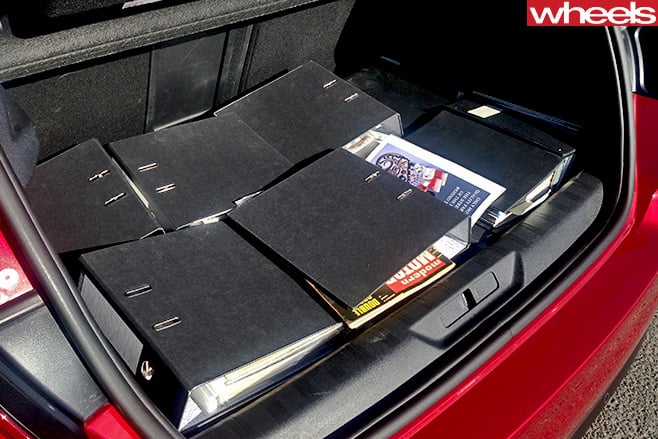
Having done virtually the same journey in the C4 Picasso, without a load, the 308’s effortlessness on the Hume is even more incredible. The torque is so terrific that the Aisin six-speed auto only kicked back to fifth once on the entire trip. The unladen Citroen has a better power-to-weight ratio (92kW per tonne versus 83), but the three-pot’s performance transcends what its on-paper specs promise.
And the economy! Despite that load and several foot-flat extensions up through its rev range after pit stops or dispatching slow-moving traffic, the 308 1.2 auto averaged 6.8L/100km for the journey, and that includes three days of city slogging with the same load. In the Citroen, I clocked 8.1L/100km.
Both PSA cars share a few faults, like a Bluetooth phone system that must have its volume level at less than 20 or it echoes in the caller’s ears, and the fiddly procedure for choosing tracks with an iPod plugged into the multimedia system. But they’re minor irritations you can work around.
What shone most is the 308’s cohesion. I think it makes better use of its EMP2 platform than the Picasso, particularly in terms of general agility and urban ride. Yet both are superb at smashing out day-long drives minus fatigue and discomfort. Not to mention excuses. Finally, here’s a small Peugeot hatchback you’ll want to own for reasons other than the way it looks.





